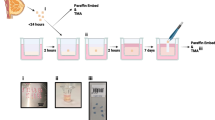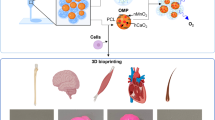Abstract
In this paper, we present a 3D printed tumor spheroidal model suitable for drug discovery. This model is based on a hydroxyethyl cellulose/alginate/gelatin (HCSG) composite biomaterial that has three distinct properties: (1) the HCSG is similar to the commercial basement membrane extract in Ki67, MUC1, and PARP1 expressions of MCF-7 cells for embedding culture; (2) the HCSG is printable at room temperature; and (3) the HCSG can be large-scale manufactured at an ultralow cost. We printed a 3D MCF-7 spheroid model with HCSG and characterized it in terms of cell viability, spheroid size, key protein expression, and mitochondrial metabolic activity. We used the 3D MCF-7 spheroid model to evaluate the anti-breast cancer activity of 13 amino acid-based flavone phosphoramidates and found that the alanine structure induced a stronger drug resistance, whereas phenylalanine hardly caused drug resistance in the MCF-7 cells. This is the first time that 3D bioprinting technology has been used in a structure–activity relationship study.





Similar content being viewed by others
References
Rohall SL, Auch L, Gable J, Gora J, Jansen J, Lu Y, Martin E, Pancost-Heidebrecht M, Shirley B, Stiefl N, Lindvall M (2020) An artificial intelligence approach to proactively inspire drug discovery with recommendations. J Med Chem. https://doi.org/10.1021/acs.jmedchem.9b02130
Li F, Cao L, Parikh S, Zuo R (2020) Three-dimensional spheroids with primary human liver cells and differential roles of kupffer cells in drug-induced liver injury. J Pharm Sci 109(6):1912–1923. https://doi.org/10.1016/j.xphs.2020.02.021
Beaurivage C, Naumovska E, Chang YX, Elstak ED, Nicolas A, Wouters H, van Moolenbroek G, Lanz HL, Trietsch SJ, Joore J, Vulto P, Janssen RAJ, Erdmann KS, Stallen J, Kurek D (2019) Development of a gut-on-a-chip model for high throughput disease modeling and drug discovery. Int J Mol Sci 20(22):5661. https://doi.org/10.3390/ijms20225661
Marotta N, Kim S, Krainc D (2020) Organoid and pluripotent stem cells in Parkinson’s disease modeling: an expert view on their value to drug discovery. Expert Opin Drug Discov 15(4):427–441. https://doi.org/10.1080/17460441.2020.1703671
Gardin C, Ferroni L, Latremouille C, Chachques JC, Mitrecic D, Zavan B (2020) Recent applications of three dimensional printing in cardiovascular medicine. Cells. https://doi.org/10.3390/cells9030742
Zhao Y, Yao R, Ouyang L, Ding H, Zhang T, Zhang K, Cheng S, Sun W (2014) Three-dimensional printing of Hela cells for cervical tumor model in vitro. Biofabrication 6(3):035001. https://doi.org/10.1088/1758-5082/6/3/035001
King SM, Presnell SC, Nguyen DG (2014) Development of 3D bioprinted human breast cancer for in vitro drug screening. Cancer Res 74(19):5. https://doi.org/10.1158/1538-7445.am2014-2034
Brancato V, Oliveira JM, Correlo VM, Reis RL, Kundu SC (2020) Could 3D models of cancer enhance drug screening? Biomaterials 232:119744. https://doi.org/10.1016/j.biomaterials.2019.119744
Salib JY, El-Toumy SA, Hassan EM, Shafik NH, Abdel-Latif SM, Brouard I (2014) New quinoline alkaloid from Ruta graveolens aerial parts and evaluation of the antifertility activity. Nat Prod Res 28(17):1335–1342. https://doi.org/10.1080/14786419.2014.903395
Cos P, Ying L, Calomme M, Hu JP, Cimanga K, Van Poel B, Pieters L, Vlietinck AJ, Vanden Berghe D (1998) Structure–activity relationship and classification of flavonoids as inhibitors of xanthine oxidase and superoxide scavengers. J Nat Prod 61(1):71–76. https://doi.org/10.1021/np970237h
Wang J, Zhang X, Li X, Zhang Y, Hou T, Wei L, Qu L, Shi L, Liu Y, Zou L, Liang X (2016) Anti-gastric cancer activity in three-dimensional tumor spheroids of bufadienolides. Sci Rep 6:24772. https://doi.org/10.1038/srep24772
Albritton JL, Miller JS (2017) 3D bioprinting: improving in vitro models of metastasis with heterogeneous tumor microenvironments. Dis Model Mech 10(1):3–14. https://doi.org/10.1242/dmm.025049
Knowlton S, Onal S, Yu CH, Zhao JJ, Tasoglu S (2015) Bioprinting for cancer research. Trends Biotechnol 33(9):504–513. https://doi.org/10.1016/j.tibtech.2015.06.007
Meng F, Meyer CM, Joung D, Vallera DA, McAlpine MC, Panoskaltsis-Mortari A (2019) 3D bioprinted in vitro metastatic models via reconstruction of tumor microenvironments. Adv Mater 31:e1806899. https://doi.org/10.1002/adma.201806899
Zhang YS, Duchamp M, Oklu R, Ellisen LW, Langer R, Khademhosseini A (2016) Bioprinting the cancer microenvironment. ACS Biomater Sci Eng 2(10):1710–1721. https://doi.org/10.1021/acsbiomaterials.6b00246
Guestini F, Ono K, Miyashita M, Ishida T, Ohuchi N, Nakagawa S, Hirakawa H, Tamaki K, Ohi Y, Rai Y, Sagara Y, Sasano H, McNamara KM (2018) Impact of Topoisomerase IIalpha, PTEN, ABCC1/MRP1, and KI67 on triple-negative breast cancer patients treated with neoadjuvant chemotherapy. Breast Cancer Res Treat 173(2):275–288. https://doi.org/10.1007/s10549-018-4985-6
Zhang L, Wang L, Dong D, Wang Z, Ji W, Yu M, Zhang F, Niu R, Zhou Y (2018) MiR-34b/c-5p and the neurokinin-1 receptor regulate breast cancer cell proliferation and apoptosis. Cell Prolif 52(1):e12527. https://doi.org/10.1111/cpr.12527
Kaushal N, Tiruchinapally G, Durmaz YY, Bao L, Gilani R, Merajver SD, ElSayed MEH (2018) Synergistic inhibition of aggressive breast cancer cell migration and invasion by cytoplasmic delivery of anti-RhoC silencing RNA and presentation of EPPT1 peptide on “smart” particles. J Control Release 289:79–93. https://doi.org/10.1016/j.jconrel.2018.07.042
Islam F, Gopalan V, Lam AK, Kabir SR (2018) Pea lectin inhibits cell growth by inducing apoptosis in SW480 and SW48 cell lines. Int J Biol Macromol 117:1050–1057. https://doi.org/10.1016/j.ijbiomac.2018.06.021
Zhong C, Xie H-Y, Zhou L, Xu X, Zheng S-S (2016) Human hepatocytes loaded in 3D bioprinting generate mini-liver. Hepatobiliary Pancreat Dis Int 15(5):512–518. https://doi.org/10.1016/s1499-3872(16)60119-4
Pimentel CR, Ko SK, Caviglia C, Wolff A, Emneus J, Keller SS, Dufva M (2018) Three-dimensional fabrication of thick and densely populated soft constructs with complex and actively perfused channel network. Acta Biomater 65:174–184. https://doi.org/10.1016/j.actbio.2017.10.047
Li YQ, Yang F, Wang L, Cao Z, Han TJ, Duan ZA, Li Z, Zhao WJ (2016) Phosphoramidate protides of five flavones and their antiproliferative activity against HepG2 and L-O2 cell lines. Eur J Med Chem 112:196–208. https://doi.org/10.1016/j.ejmech.2016.02.012
Benton G, Kleinman HK, George J, Arnaoutova I (2011) Multiple uses of basement membrane-like matrix (BME/Matrigel) in vitro and in vivo with cancer cells. Int J Cancer 128(8):1751–1757. https://doi.org/10.1002/ijc.25781
Zehnder T, Sarker B, Boccaccini AR, Detsch R (2015) Evaluation of an alginate-gelatine crosslinked hydrogel for bioplotting. Biofabrication 7(2):025001. https://doi.org/10.1016/j.biomaterials.2015.05.031
Neufurth M, Wang X, Schroder HC, Feng Q, Diehl-Seifert B, Ziebart T, Steffen R, Wang S, Muller WEG (2014) Engineering a morphogenetically active hydrogel for bioprinting of bioartificial tissue derived from human osteoblast-like SaOS-2 cells. Biomaterials 35(31):8810–8819. https://doi.org/10.1016/j.biomaterials.2014.07.002
Ouyang L, Yao R, Chen X, Na J, Sun W (2015) 3D printing of HEK 293FT cell-laden hydrogel into macroporous constructs with high cell viability and normal biological functions. Biofabrication 7(1):015010. https://doi.org/10.1088/1758-5090/7/1/015010
Saito M, Shinbo T, Saito T, Kato H, Otagiri H, Karaki Y, Tazawa K, Fujimaki M (1990) Temperature sensitivity on proliferation and morphologic alteration of human esophageal carcinoma cells in culture. Vitro Cell Dev Biol 26(2):181–186. https://doi.org/10.1007/BF02624110
Sugasawa T, Mukai N, Tamura K, Tamba T, Mori S, Miyashiro Y, Yamaguchi M, Nissato S, Ra S, Yoshida Y, Hoshino M, Ohmori H, Kawakami Y, Takekoshi K (2016) Effects of cold stimulation on mitochondrial activity and VEGF expression in vitro. Int J Sports Med 37(10):766–778. https://doi.org/10.1055/s-0042-102659
Yasuhara R, Kushida R, Ishii S, Yamanoha B, Shimizu A (2013) Effects of pressure and temperature on the survival rate of adherent A-172 cells. High Press Res 33(2):322–327. https://doi.org/10.1080/08957959.2013.780054
Kamel S, Ali N, Jahangir K, Shah SM, El-Gendy AA (2008) Pharmaceutical significance of cellulose: a review. Express Polym Lett 2(11):758–778. https://doi.org/10.3144/expresspolymlett.2008.90
Zulkifli FH, Hussain FS, Rasad MS, Mohd Yusoff M (2014) Nanostructured materials from hydroxyethyl cellulose for skin tissue engineering. Carbohydr Polym 114:238–245. https://doi.org/10.1016/j.carbpol.2014.08.019
Chahal S, Hussain FSJ, Yusoff MM, Abdull Rasad MSB, Kumar A (2016) Nanohydroxyapatite-coated hydroxyethyl cellulose/poly (vinyl) alcohol electrospun scaffolds and their cellular response. Int J Polym Mater Polym Biomater 66(3):115–122. https://doi.org/10.1080/00914037.2016.1190926
Acknowledgements
This work was supported by the National Natural Science Foundation of China (No. 21675017), State Key Laboratory for Managing Biotic and Chemical Threats to the Quality and Safety of Agro-products (KF20190108), and the National Key Research and Development Program of China (No. 2017YFC1702001). And we thanked Prof. Yueqing Li for the synthesis of the isoflavone derivatives and useful discussions.
Author information
Authors and Affiliations
Contributions
Y. Luo and X.L. Zhang conceived this study. The manuscript was written through contributions of all authors. All authors have given approval to the final version of the manuscript. X.R. Li and Q.F. Deng contributed equally to this work.
Corresponding authors
Ethics declarations
Conflict of interest
The authors declare no conflict of interest.
Ethical Approval
This study does not contain any studies with human or animal subjects performed by any of the authors.
Electronic supplementary material
Below is the link to the electronic supplementary material.
Rights and permissions
About this article
Cite this article
Li, X., Deng, Q., Zhuang, T. et al. 3D bioprinted breast tumor model for structure–activity relationship study. Bio-des. Manuf. 3, 361–372 (2020). https://doi.org/10.1007/s42242-020-00085-5
Received:
Accepted:
Published:
Issue Date:
DOI: https://doi.org/10.1007/s42242-020-00085-5




